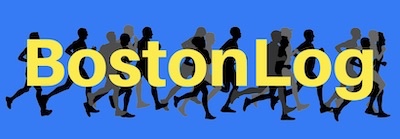In 2007, I wrote a post in my Myspace blog in which I discussed the differences among plans, goals, dreams, and fantasies. Qualifying for the Boston Marathon fell into the “dreams” category at that point. My marathon times were nowhere near fast enough for Boston to seem feasible, but I thought if I continued to progress, I might get there eventually.
I initially approached qualifying for the Boston Marathon as someone who enjoyed the personal satisfaction of running marathons and wanted to get to the next level. But at some point, things progressed far beyond having a competitive spirit. What began as a far-away dream gradually transformed into a vicious cycle of self-inflicted torture. Depression, sleeplessness, starvation, anxiety, isolation, and a slew of other “symptoms” characterized my pursuit of this one prestigious race.
It took me seven years to qualify for the Boston Marathon. Ironically, if I hadn’t tied myself up in knots trying to prove I was worthy of the Boston Marathon, I probably would have already run the race several times.
That seven year journey is about much more than a sporting event. It’s a story about chasing after a dream, and how it can define you, destroy you, and rebuild you. Sound dramatic? Well, it was. So much so I’ve written a book about it entitled Boston Bound, in which I explore my love/hate relationship with the Boston Marathon, with running, and with myself.
The word “neutral” wasn’t part of my vocabulary, but over time I’ve learned neutrality is the key to success in the sport. Ultimately, if it weren’t for my relentless attempts at qualifying for the Boston Marathon, I wouldn’t be the person I am today. Just like running a marathon, the only way out of it was through it. Here’s my account of the resulting 26.2 miles to Boston:
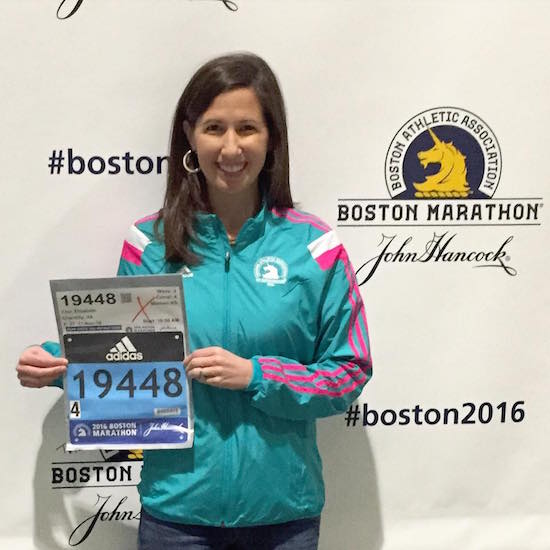
It finally happened. After setting my sights on Boston in March 2008, I finally ran the race, eight years later, and ten years after running my first marathon in 2006. The Boston Marathon was my 20th marathon finish.
The Journey to Hopkinton
Race morning arrived, and after a semi-sleepless but restful night (not sleeping, but laying completely relaxed and still) I got ready for the race. I made my UCAN gel, applied massive amounts of body glide, applied sunscreen, got dressed, pinned my bib to my skirt, and was ready to go. Greg and I met our friend Amber in the hotel lobby and we walked to Boston Common where the buses would bring us to the start line in Hopkinton.
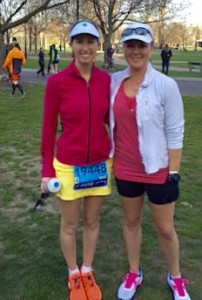
I felt relaxed. It didn’t really feel real. As we approached the bus loading area, I heard the announcer directing people. Then it started to feel real– with an official announcer telling people where to go and when. Even though I went to the bathroom immediately before leaving the hotel, I had to go again once we reached the buses, but I decided to wait until we arrived. I said goodbye to Greg, gave him a hug, and he told me to look for him just before Mile 20.
Amber and I boarded a bus immediately without having to wait in line, and it departed shortly after. The bus driver said the ride would be about 35 minutes, but it actually took 50. I liked the bus ride, but I had to pee pretty badly, so by the end of the trip I was really ready to get off the bus. During the bus ride, Amber and I chatted about our training, our running history, and our jobs. Our husbands know each other from high school, but the two of us had only ever met via Facebook and Strava. So there was a lot to talk about. I felt surprisingly calm. It didn’t at all feel like I was about to run the Boston Marathon.
At 8:20, I ate my bagel with peanut butter. I thought I would end up having to eat it as we were getting off the bus, but since the ride was longer than expected, I ate the whole thing on the bus. I was actually only hungry for about 2/3 of it, and I didn’t force-feed myself the rest. I had eaten a banana at 6:30, as well as a good-sized dinner the night before, so I wasn’t worried about getting enough calories.
The Athletes’ Village
We arrived in the village, which was basically a huge field with tents. There were loads of porta potties, but there were loads of people to go along with them! We waited in line for about 20 minutes and then afterwards found a spot to sit down and relax. The starting village vibe was really exciting. There were people sleeping (or who appeared to be sleeping) on the ground with pillows and blankets. Many people were on the grassy area outside of the tent, but I knew it was really important to keep cool beforehand, so we stayed in the shade of the tent. I looked around and realized these runners were some of the fastest marathoners in the world. I took a moment to appreciate the fact I was there, in Hopkinton, about to run the Boston Marathon with thousands of others who had also put in the hard work to get there.
With about 20 minutes to go before they called our wave, I waited in the bathroom line again to go one last time. I hadn’t had anything to drink since going to the bathroom the first time, but yet I still needed to go again. I guess this was a sign maybe I had drunk too much water the day before and in the hotel room, but it honestly didn’t feel like that much water. And I was also using Salt Stick tabs and UCAN hydrate, which contains electrolytes.
They called our wave and before heading to the start line, I soaked my two “cooling towels” and cooling wrist bands in water and ditched my cover-up jacket. The walk from the village to the start line was about 3/4 of a mile, but it was so exciting and fun. There were volunteers and Hopkinton residents along the way offering us sunscreen, and there were even people who had black markers to write our names on our arms. I had them write “ZEBRA” on my arm! I felt like a total rockstar with so many people there cheering and helping us get ready.
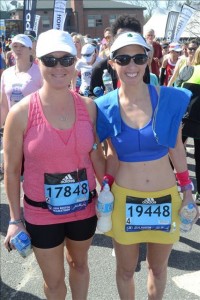
As I stood in my corral I used my two cooling towels to keep myself cool, but they only went so far. I mainly focused on my shoulders and neck, and occasionally my face. I had also poured a ton of water onto my head before departing the village, and by the time I arrived at the start, my head was already dry. At the start line, people were remarking how warm it was. One person checked her phone and reported it was 71 degrees. With no shade and not a single cloud in the sky, we were all baking before we even got started.
With five minutes to go, things started to feel more real- but part of me still didn’t really feel like this was Boston. It was actually more surreal than anything. And I was really relaxed. The former me would have been really upset about how warm it was at the start line, but instead I thought to myself we were are all in this together, and I was still going to run the best race I possibly could, no matter what the result.
Miles 1-4: Hopkinton and Ashland
The race started and I stayed relaxed. I was happy and confident and I knew exactly what I needed to do. The race was really crowded during these miles, as expected, and I didn’t want to expend energy weaving through people, so I pretty much just went with the flow and kept everything feeling nice and easy. I found myself running slightly slower than an 8:00/mile pace, which seemed appropriate. My training runs and the Shamrock Half Marathon indicated I had the fitness level to run a pace of 7:40, or perhaps even faster. But all of those runs were in temperatures 55 degrees or cooler, so I wasn’t sure how much to adjust for the heat and sunshine. Knowing my history of running in similar conditions, I thought 20 seconds/mile slower would be phenomenal, and 30 seconds/mile slower would still be pretty good. I decided to go for my “phenomenal” scenario, given I had several cooling strategies.
I tossed one of my cooling towels at the start, but I kept the other one tucked into my skirt for the first few miles, and every few minutes I would use it to cool my face and neck. I also had cooling wrist bands made of the same material, and supposedly if you can keep your inner wrists cool, then your overall body temperature will be cooler. I also decided to dump three to four cups of water on myself at each water station. On my chest, over my head, and on the cooling wrist bands.
We reached the first water station at Mile 2. I carried a water bottle for drinking, and I only used the water station cups for tossing on myself. My plan was to drink water every 15 minutes, and take Salt Stick tabs every 45 minutes, as indicated on the bottle. I was careful not to drink too much. I was surprised the water stations weren’t marked with signage in advance like at other races, but thankfully Gatorade was offered first, so as soon as I saw that, I knew water would be next. The water stations were really chaotic. Usually I avoid water stations in races by carrying my own bottle, but with this race, I took three or four cups at each station and doused myself with them.
My focus during these early miles was staying relaxed, keeping things feeling easy, going with the flow, and staying as cool as possible. I really didn’t know how to best “save” my quads other than to prevent any start/stop motion and not to expend extra energy trying to defy the gravitational pull of the downhill. I tried to be really light on my feet and keep my entire body loose.
Elevation from Strava data
Mile 1: 8:11 (-111 ft)
Mile 2: 8:03 (-55 ft)
Mile 3: 8:01 (-50 ft)
Mile 4: 7:54 (-63 ft)
Miles 5-8: Framingham
The crowd was still thick at this point, but I finally felt like I could move about more freely than before. I focused on executing my race plan, which was drinking water every 15 minutes, using the cooling towel I now had stored in my sports bra, and staying relaxed. I felt really good during these miles and the pace still felt ridiculously easy. It did not feel like marathon pace at all. It felt like I was out for an easy training run. So I wasn’t worried I was going out too fast.
The spectators were incredible. Usually I don’t like a ton of people screaming and yelling as I run—I prefer peace and quiet, so I can be in “zen” mode. But in the case of Boston, it was all about the fanfare and I was taking it all in. Even though I was really focused on executing my race strategy, I didn’t want to forget I was running the Boston Marathon, so I kept reminding myself to soak it all in and relish in the experience. Usually when I run I am not focused on what goes on around me—I am more focused on execution. But in Boston, I didn’t want to “miss” the experience! I also paid attention to the people running around me. Every single one of these people had qualified for Boston. They all knew what they were doing, at least to some extent!
Somewhere around Mile 8, I saw a kid on the side of the course handing out bags of ice. YES! I took a bag from him, and put all of the ice directly into my sports bra, ditching the cooling towel. I knew this would cause major chafing, but I didn’t care. I had heard ice in the sports bra was a great way to stay cool, and so I did it. The ice jiggled around as I ran, and I hoped it would have the desired effect of cooling my core. It was still quite warm, with not a cloud in the sky. And the course was not shaded.
Mile 5: 8:04 (+8 ft)
Mile 6: 7:49 (-15 ft)
Mile 7: 7:54 (-12 ft)
Mile 8: 8:07 (-1 ft)
Miles 9-12: Natick
During Mile 9, someone handed me an entire bottle of water. This was a lifesaver because I didn’t have enough water in my handheld bottle to take my UCAN gel with as planned. It takes about a full minute to consume the whole gel, and I need to run/drink while doing it. So having a handheld bottle with enough water is essential. Without that extra bottle, I would have had to refill my own bottle at a water station, which would have cost me at least 20 seconds. So I was double-fisting it for about two miles. One water bottle in each hand was not comfortable, but it was better than having to stop to re-fill my own bottle.
85 minutes into the race, I took the gel/water. It went down easily and it was nice to not have to carry the gel in my skirt anymore. I also knew I could toss my handheld bottle at any point because I no longer needed it for fueling. I planned to take some chews later in the race, but I didn’t need water at the exact time I ate those.
Whenever I crossed over a timing mat, I got excited because I knew Greg and others tracking me would see the split. I was feeling really strong as I crossed the 15K point, and my spirits were high. The spectators continued to line the streets with signs and cold towels and I focused on soaking it all in. I also focused on keeping myself nice and soaked with three to four cups of water at each station. It was amazing how fast I would dry off between the water stations, only a mile apart! The sun was still high in the sky without a cloud in sight. I was expecting it to get cooler as we ran toward Boston, but I wasn’t feeling that yet. These were the fastest miles of my race:
Mile 9: 7:58 (-12 ft)
Mile 10: 7:59 (+13 ft)
Mile 11: 8:12 (+28 ft)
Mile 12: 7:57 (-51 ft)
Miles 13-16: Wellesley
I could hear the Wellesley College women screaming well before I even arrived. The cheering at this point was insane! I can’t even imagine screaming that loudly for so long. It was exhilarating and I felt amazing! I ditched my handheld water bottle at this point, and would rely on water stations for drinking.
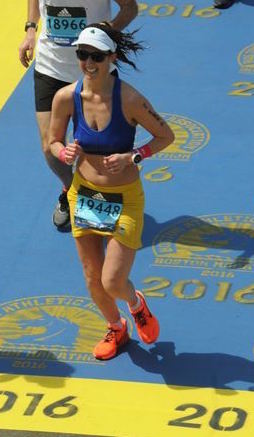
I came through the halfway point in 1:45:39, which is an average pace of 8:03. I was primed to run a 3:31 at that point and I felt confident I’d be able to do it. I had held my pace steady for the first half, according to plan, and my energy level still felt high. My quads started to feel sore at around Mile 13, but I figured that was normal in Boston. They didn’t feel “beat up” or “trashed,” just noticeably sore, and I figured they would hold out for the rest of the race. Plus, I would use my glutes to power myself uphill and those felt great! Also, there wouldn’t be a ton of downhill until the very end to cause my quads to hurt even more, so I thought I was in really great shape. As I approached Mile marker 16, I knew the tough stuff was about to start. I prepared myself mentally and reminded myself this is what I had trained so hard for. This part.
Mile 13: 8:07 (0 ft)
Mile 14: 8:04 (-4 ft)
Mile 15: 8:11 (+23 ft)
Mile 16: 7:56 (-124 ft)
Miles 17-20: Newton
Greg McMillan had told me and his other athletes the day before that Mile 17 was the mile to watch out for, and it’s where most runners fall apart. He said by that point, you’ve been running downhill for 16 miles, that even running on a flat surface feels like you need to expend more effort. He told us we’d need to increase the effort level here to maintain the same pace. It should have felt relatively easy up until now, and now is when it would start feeling like a race. I told myself I would be strong during the first Newton hill at Mile 17 and I wouldn’t be one of those people who fell apart. I had run a smart race up until now. I felt good, and I would continue to execute my race strategy. I was still drinking water every 15 minutes, and I had taken two Salt Stick pills by the time I reached Mile 20.
As I ran up the first hill, I reminded myself this was one of five, and I would tackle them one a time, like how I tackle intervals on a track. There are actually only four Newton hills, but at the time I thought there were five for some reason. I slowed my pace slightly to get up the first hill, but I felt good and once I saw Mile marker 17, I was so excited I was still “in the game” and feeling good. It was then time for Newton hill #2. I pushed my way up it, telling myself to increase the effort level, and I made it to the top, no problem! Yes! Almost halfway done with the hills. Mile 19 was a nice treat because it was mainly downhill, and I felt pretty good going down it.
Okay, time for hill #3. This one was definitely harder than the others, but still manageable. I knew I just needed to make it through the hills and the rest of the race would be easier. I ran up the third hill slower than the first two, but still with a good deal of confidence. I could feel my quads, but the amount of pain felt sustainable. I was starting to feel tired and I was slowing down slightly, but I told myself it was just a rough patch and I would get over it.
I looked for Greg as I approached Mile marker 20, but I didn’t see him. I did, however, hear my friend Lynn screaming my name after I had almost passed her. I looked back and saw her and it was definitely a nice pick-me-up.
Mile 17: 8:26 (+74 ft)
Mile 18: 8:23 (+45 ft)
Mile 19: 8:16 (-32 ft)
Mile 20: 9:11 (+17 ft)
Mile 21: Heartbreak Hill
This mile gets its own section in the story! Before making my way up the hill, I gave myself a pep talk. I was feeling decent, considering it was Mile 21, but things had definitely gotten hard. I told myself I just needed to make it to the top and then the race would be mine.
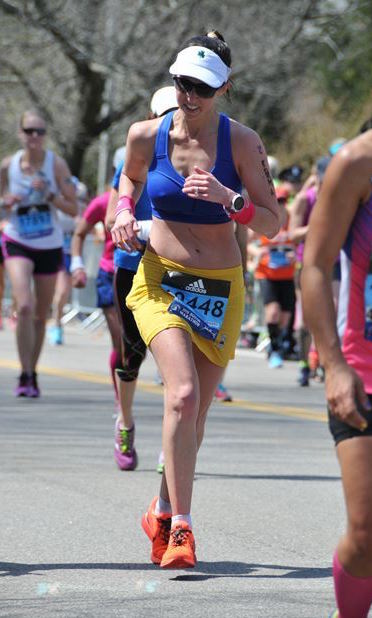
This hell. This hill. THIS HILL. . . words cannot even describe the struggle. It was sheer torture trying to climb that thing. It felt like Mt. Everest even though I had run longer/steeper hills in training. I didn’t look at my pace as I climbed. I focused on my form– using my glutes, leaning in, pumping my arms. There was a man nearby who looked to be in his 70’s who was also trying to get up the hill. He said to me “we’ll make it to Boston one way or another!” I started to get ahead of him and I looked back and waved him toward me. “Come on!” I encouraged him. He ran with me for about 15 seconds and then fell behind me. “Come on!” I yelled back to him. It was helping me get up the hill by focusing on getting him up the hill. Ultimately, he couldn’t keep up with my speedy 10:00 pace (note the sarcasm).
Major carnage everywhere. About half the field was walking. I told myself I would not walk. I would not walk up Heartbreak Hell Hill, no matter what. When a hill gets hard for me I usually look only about 15 to 20 feet ahead of me on the ground, and I tell myself, “just get to that point on the road.” And then when I reach it, I pick another point ahead of me and I tell myself, “just get that that point on the road.” I do this until I am safely up the hill. You can see that’s what I am doing in the photo, focusing on a single point and propelling myself up the hill. It was truly a painful experience and I am so glad I ran up the hill, and passed a few people on it. Some people passed me, so I was worse off than some people, but better off than others.
I really was hoping it would have cooled down by this point in the race, and maybe it had dropped a few degrees. If so, I couldn’t feel it.
Mile 21: 10:06 (+96 ft)
Miles 22-24: Brighton and Brookline
There was a sign at the top of Heartbreak Hill that said “Top of Heartbreak Hill” and once I saw that sign I was so relieved. But I felt so dead once I reached the top, that I had come to the realization the rest of the race would not be as rosy as I had originally anticipated.
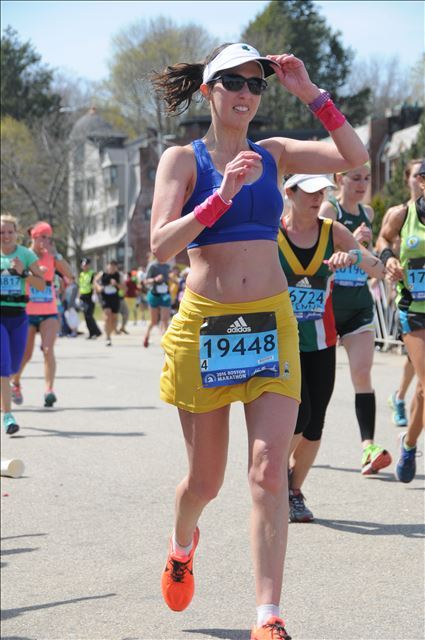
I ate about three of my chews, and that’s all I could really stomach. Everything hurt. I was tired, my quads were worthless. Every step I took send a pain through my quads and it was misery. Running hurt so much. Even though Mile 22 was downhill– I ran it at the same pace as Heartbreak Hill because I was just dead at that point. I couldn’t muster any more energy.
There was also a bit of a headwind at this point. I welcomed it because it cooled me off, but it was contributing to the effort level I needed to expend to move forward. It was finally noticeably cooler, it was downhill, and yet I couldn’t take advantage of these circumstances because I had baked during the first 22 miles.
I really didn’t want to walk and I knew walking would only prolong the situation, but there were a few times during Miles 23 and 24 where I had to stop for about ten seconds at a time just to mentally reset. I came to the realization I would not be re-qualifying for Boston on this day and I was totally fine with that. I had no desire to revisit this punishing course again anytime soon (although I think I will be ready in 2018) so that was the least of my worries. I felt like death, so obviously NOT having an opportunity to come back next year and face this same challenge wasn’t a concern!
It was the survival shuffle for these miles and I was motivated by the fact I wanted to really give 100% of myself to this race. I didn’t want to look back on my experience thinking I could have tried harder. So I tried as hard as I possibly could to make it through those final miles. I knew there were loads of people tracking me and waiting for me to come through that 40K, and I wanted to get there as quickly as my body would allow me to.
Even though these miles are net downhill, there were still some nasty uphills thrown in there.
Mile 22: 10:04 (-80 ft)
Mile 23: 10:49 (-48 ft)
Mile 24: 10:31 (-50 ft)
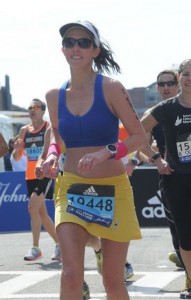
Miles 25-26.4: Boston
I really, really wanted the race to be over, and I felt guilty for feeling that way. I was supposed to be having the time of my life! I had been dreaming about this for so long, and here I was, wanting it to be over. I told myself to feel joy, excitement, and pride! I told myself to savor the experience. But I hurt so badly. All I could focus on was the pain. I tried smiling. I constantly reminded myself this was the Boston Marathon and couldn’t I just really enjoy it? Nope, not happening. This was a death march all the way to right turn on Hereford during the last mile.
I told myself I really did not want to walk or stop. But there were some points where I did stop for a few seconds because the pain became unbearable. I was exhausted. My quads were on fire. Every step was torture. In order to prevent stopping and walking, I gave myself a new time goal. Sub-3:50. I told myself if I walked or stopped, I would be in the 3:50’s and I really wouldn’t be happy with that. Mainly because it took me five years to break 3:50, so being in the 3:40’s is like a whole different world to me. Many runners were walking and doing the same “survival shuffle” I was. I was only passed by a few runners who seemed to be doing really well. I was passed by other people who were struggling, but not struggling as badly as I was. So, there was a wide range of struggle, but people running strongly were definitely the exception and not the rule.
When I made the right on Hereford, I used my time there to give myself a pep talk for Boylston. I told myself I would run all the way down Boylston with everything I had in me. I would muster every ounce of energy I had to get there, and I would do it with a smile.
So down Boylston I ran. This was where the bombings happened. This was the most famed marathon finish line in the whole world. My spirits lifted. I truly felt like death but I refused to let myself stop and I refused to focus on how bad I felt. Instead, I set my sights on the finish line arch, and went for it with all the passion I could find.
I glanced down at my watch and I saw that a 3:48:xx was within my grasp and I was determined to get it.
Mile 25: 9:41 (-41 ft)
Mile 26: 10:20 (+2 ft)
Final 0.4 9:29 (-2 ft)
The Finish and Beyond
I crossed the finish line and I was so happy to be done with the race! I wish I could say this overwhelming sense of pride and achievement came over me, but the primary emotion was just relief. I was so glad I didn’t have to run one more step.
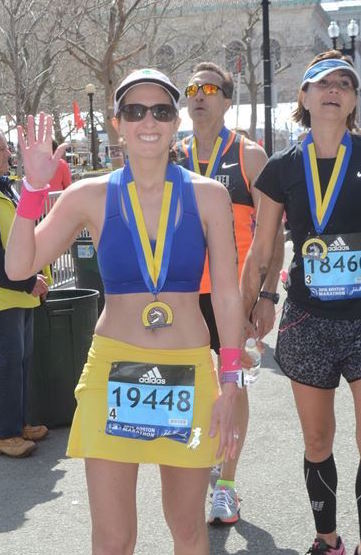
I knew I only had to walk about 1/3 a mile to get to Greg in the family meeting area. I wanted to see him so badly. As I walked through the finish line shute, I collected my medal and had my photo taken. The more I walked, the worse and worse I started to feel. I thought I would have felt better and better since I was recovering, but that’s not what happened. I almost made it to the family meeting area when I stopped walking and realized I felt really, really bad. I felt weak. I felt dizzy and nauseous. And I was confused. Someone with a wheelchair approached me and I wanted them to wheel me to Greg, but they said they had to take me to the medical tent. So I had a choice, continue walking to Greg (which is what I really wanted) or take a wheelchair ride to the medical tent. I broke down crying and started hyperventilating (a mini-panic attack) as I realized the medical tent was my only option.
That medical tent was a well-oiled machine! They scanned my bib, checked me in and sent me to cot #12. They started asking me questions like what my name was and if I knew where I was, and my speech was far from normal. It was hard to get the words out. I spoke slowly and with slurred speech.
They laid me down on a cot and put my feet up. They asked me about my water consumption and I said I drank more water than I usually do, but I didn’t think it was too much. Apparently I had the symptoms of hyponatremia- where your electrolytes become unbalanced due to lack of salt. I guess I sweated out a lot and didn’t take enough Salt Stick pills with my water. The fact I went to the bathroom so much before the race even started was probably an indication I had perhaps drunk too much. It’s really hard to get the right balance because I definitely did not want to become dehydrated. All of my training runs were in 55-degree weather or cooler, so this wasn’t something I had practiced recently.
They let me use a phone to call Greg and I told him I would meet him at the hotel, which was actually closer to the medical tent than the family meeting area. One of the nice things about the Boston Marathon is that stuff is pretty close together. Hotels are near the expo and finish line so logistics are fairly easy.
The medical tent people gave me a salty broth to drink and I felt much better after having that. But suddenly I became very cold and my temperature dropped to 94.3. My hands turned blue and I started shivering. Well, this was because I was soaking wet from pouring so much water on myself, I had stopped moving, and I was in the shade now, with the Boston temperature only being 58 degrees. Finally I was able to leave the medical tent and make my way to the hotel to meet Greg.
I was so happy to finally be re-united with him! I had so much to tell him and I didn’t even know where to start. I was shivering, so the first order of business was to take a warm bath. After that, I really wanted to go to the McMillan post-race party, but I felt really sick still, so I decided I just wanted to stay in the hotel room for the rest of the evening. I was bummed I didn’t get to enjoy any of the finish line festivities and celebratory events after all that hard work, but my body didn’t want to move. I certainly didn’t want to make myself look presentable to go outside, either!
Official Stats and Final Thoughts
My official finish time was 3:48:16. My Garmin clocked 26.4 miles at a pace of 8:38, with my marathon “effort” being a 3:46:36.
I placed 13,356 out of 26,639 total runners. This puts me right in the middle of the field. However, the average finish time was 3:55:03, which means my time was about seven minutes faster than average.
I placed 4,564 out of 12,168 women, which puts me in the top 37.5%, which I am very pleased with. As for my division (18-39), I placed 3,011, but I have no idea how many people were in my division. I imagine I was on the slower end because women ages 18-34 need to have a faster BQ time than I did. Not sure why I’m in the same division with them when they have a tougher standard, but I don’t really care that much!
To further illustrate how rough these conditions were, only 36% of the field re-qualified for Boston 2017. This is the second-lowest re-qualifying rate in the past decade. The only race to surpass it was 2012, when temperatures rose into the 80’s.
My bib number was 19448, which should mean my BQ time was the 19,448th fastest, compared to my 13,356 overall finish. So that was nice to see. Apparently almost everyone had a really tough day and missed their goals by 15-20 minutes. Some people missed it by even more. In 2015, when there was a sustained 20 mph headwind + rain, the average finish time was 3:46:28– about nine minutes faster! Plus, the field last year was not as competitive because the BQ cutoff time was smaller. So basically, the conditions this year sucked and most people struggled. That’s all part of marathoning. You can’t control the weather and you have to do the best you can with what you’re given.
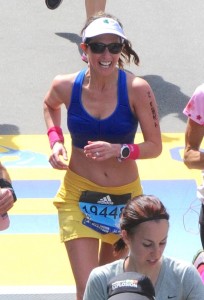 I’m extremely proud of myself for running through the end, keeping my mental state positive, and pushing through the pain. I’ve always struggled more than the average runner in the heat, and I’ve DNF’ed (did not finish) several marathons due to heat issues– when the weather wasn’t as warm as this Boston. This was a major lifetime milestone for me, and the experience seemed a bit surreal at times. I just couldn’t believe I was running THE Boston Marathon. After eight long years.
I’m extremely proud of myself for running through the end, keeping my mental state positive, and pushing through the pain. I’ve always struggled more than the average runner in the heat, and I’ve DNF’ed (did not finish) several marathons due to heat issues– when the weather wasn’t as warm as this Boston. This was a major lifetime milestone for me, and the experience seemed a bit surreal at times. I just couldn’t believe I was running THE Boston Marathon. After eight long years.
As I said earlier, I will be ready to return to Boston in 2018. This experience was rich enough and painful enough to last a few years! Now that I know I can safely run 65+ miles a week, seven days a week, without getting burned out or injured, the sky’s the limit. I do feel like I could have run a 3:25 if it were cooler yesterday, so I will chase that goal this fall and return to Boston in 2018.
Thanks to Greg for supporting me throughout this journey, and to my friends and family for all of your encouragement! My cell phone blew up with texts, emails, Facebook comments and Tweets like it never has before. And I felt really loved.
Elizabeth Clor
Chantilly, Virginia
April 18, 2016
Age – 37
Bib # 19448
3:48:16
More information on Elizabeth Clor’s book Boston Bound can be found here.
